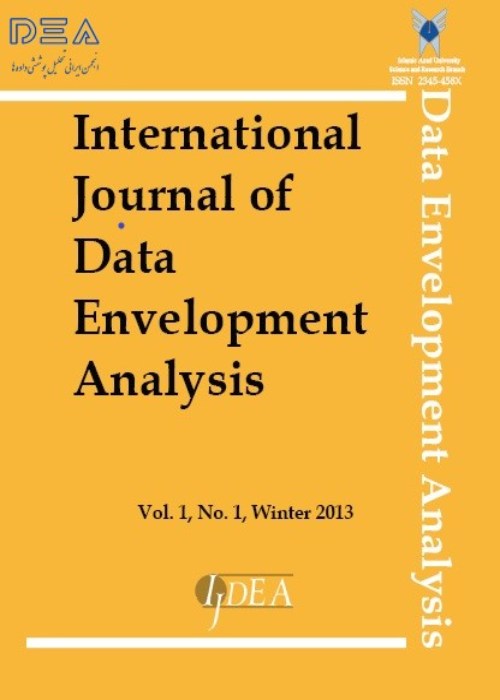فهرست مطالب
International Journal of Data Envelopment Analysis
Volume:10 Issue: 2, May 2022
- تاریخ انتشار: 1401/02/11
- تعداد عناوین: 6
-
Pages 1-12Allocating fixed shared cost and common revenue equitably to all decision making units (DMUs) are two interesting issues in resource allocation using data envelopment analysis (DEA). The existing methods have accomplished these distinctively. In this paper, we developed a single dada envelopment analysis (DEA) approach for equitable allocation of shared costs to inputs and common revenue to outputs, concurrently. The main contribution of this research in comparison with existing methods are: 1) both allocation of shared costs to inputs and common revenue to outputs are considered in a single model, simultaneously; 2) The computational efforts has been reduced and no LP required to be solved; 3) simultaneous changes of inputs and outputs have been considered in order to project a DMU towards efficient frontier. A numerical example, adopted form literature, is presented and discussed in order to illustrate the applicability and efficacy of proposed approach. Keywords: Data Envelopment Analysis, Resource Allocation, Equitable allocation of shared cost, Equitable allocation of common revenue, Modified Russell model
-
Pages 13-30
Data envelopment analysis (DEA) is a well-known approach for measuring performance of units in the presence of multiple input and output variables. Statistical control charts, on the other hand, have been developed for monitoring performance over the time and for distinguishing between in-control and out-control states. Using advantages of these approaches in this paper, an integrated model is proposed for measuring and controlling performance of unit(s) over the time. A real maintenance unit and its data are used as a case study for better understanding of the proposed model.
Keywords: Data Envelopment Analysis, Control chart, Performance evaluation, EWMA, I-MR, Super-efficiency -
Pages 31-38Ranking of fire stations is one of the most important issues in urban planning and crisis management. Because ranking increases the speed of service in crises. In the real world, the value of some attributes is non-controllable, so planners and decision makers can't change the values in the ranking process and it must be considered in the ranking. The aim of this study is ranking of fire stations candidates in district ten of Tehran municipality and for this, has used non-radial DEA model. The decision matrix consists of eleven alternatives and twelve attributes. The attributes are controllable (that the decision makers able to change values) and non-controllable (that the decision makers unable to change the values). The results show that station 5 is prioritized among the stations and has higher non-controllable attribute values in decision matrix than the others, and it validates the results.Keywords: Non-radial Model, DEA, Ranking, Fire stations
-
Pages 39-50This research tries to investigate the economic performance of the public movie Theaters halls through quantitative data through estimation of efficiency. The results of calculating the technical efficiency of the halls showed that assuming of constant return to scale (CRS), a small percentage of cinemas are efficient and the rest are inefficient, and assuming a variable return to scale (VRS), a higher percentage of cinemas are efficient. Also, the average of technical efficiency of public movie theatre halls during this period was equal to 0.60. In addition, the results show that the most important reasons for the possible inefficiency of public cinemas on the supply side, the lack of use and screening of commercial and revenue-generating movies, and on the demand side, the lack of attention to the audience's taste.Keywords: The Data Envelopment Analysis (DEA), Technical Efficiency, Public Movie Theaters, Hall, Cinema
-
Pages 51-62In this paper, a new method for centralized resource allocation based on the proposed SBM model of data envelopment analysis has been introduced. Models of DEA search targets separately for each DMU, but in this proposed model, by solving one model searches targets for all DMUs and projects all of them on the efficient frontier where this method will find a better image point rather than the previous methods. The goal is to reduce inputs and increase outputs to the non-radial. Finally, it is compared with previous methods by illustrating some examples and it seems that this method is for better.Keywords: Data Envelopment Analysis, Centralized resource allocation, Efficiency MPSS
-
Pages 63-72The weights generated by the common weights approach provide a common criterion for ranking the decision-making units (DMUs) in data envelopment analysis (DEA). Existing common weights models in DEA are either very complicated or unable to produce a full ranking for DMUs. This paper proposes a new compromise solution model to seek a common set of weights for full ranking for DMUs. The maximum inefficiency scores calculated from the standard DEA model are regarded as the anti-ideal solution for the DMUs to avoid. A common set of weights that produces the vector of inefficiency scores for the DMUs furthest to the anti-ideal solution is sought. The discrimination power of the new model is tested using two numerical examples and its potential application for fully ranking DMUs is illustrated.Keywords: Common weights, Data Envelopment Analysis, Ranking


